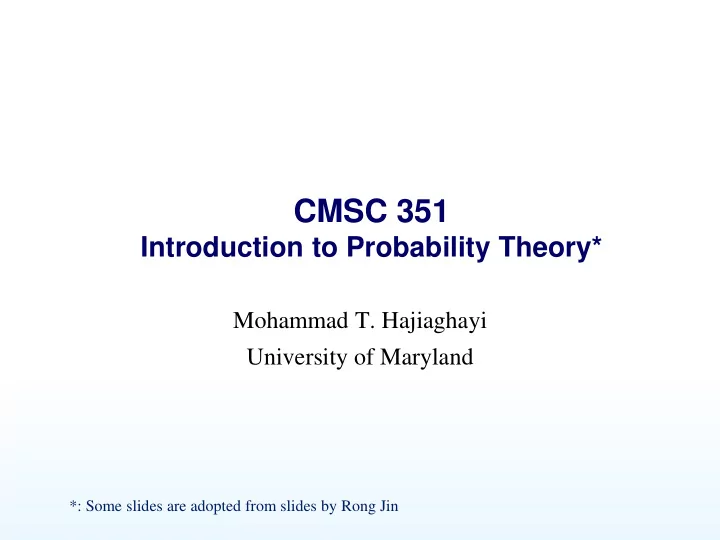

CMSC 351 Introduction to Probability Theory* Mohammad T. Hajiaghayi University of Maryland *: Some slides are adopted from slides by Rong Jin
Outline Basics of probability theory Random variable and distributions: Expectation and Variance
Definition of Probability Experiment : toss a coin twice Sample space : possible outcomes of an experiment ➢ S = {HH, HT, TH, TT} Event : a subset of possible outcomes ➢ A={HH}, B={HT, TH} Probability of an event : an number assigned to an event Pr(A) ➢ Axiom 1: 0<= Pr(A) <= 1 ➢ Axiom 2: Pr(S) = 1, Pr( ∅ )= 0 ➢ Axiom 3: For two events A and B, Pr(A ∪ B)= Pr(A)+Pr(B)- Pr(A∩B) ➢ Proposition 1: Pr(~A)= 1- Pr(A) ➢ Proposition 2: For every sequence of disjoint events Pr( ) Pr( ) i A A i i i
Joint Probability For events A and B, joint probability Pr(AB) (also shown as Pr(A ∩ B)) stands for the probability that both events happen. Example: A={HH}, B={HT, TH}, what is the joint probability Pr(AB)? Zero
Independence Two events A and B are independent in case Pr(AB) = Pr(A)Pr(B) A set of events {A i } is independent in case Pr( ) Pr( ) i A A i i i
Independence Two events A and B are independent in case Pr(AB) = Pr(A)Pr(B) A set of events {A i } is independent in case Pr( ) Pr( ) i A A i i i A = {A patient is a Woman} Example: Drug test B = {Drug fails} Women Men Will event A be independent from Success 200 1800 event B ? Failure 1800 200 Pr(A)=0.5, Pr(B)=0.5, Pr(AB)=9/20
Independence Consider the experiment of tossing a coin twice Example I: ➢ A = {HT, HH}, B = {HT} ➢ Will event A independent from event B? Example II: ➢ A = {HT}, B = {TH} ➢ Will event A independent from event B? Disjoint Independence If A is independent from B, B is independent from C, will A be independent from C? Not necessarily, say A=C
Conditioning If A and B are events with Pr(A) > 0, the conditional probability of B given A is Pr( ) AB Pr( | ) B A Pr( ) A
Conditioning If A and B are events with Pr(A) > 0, the conditional probability of B given A is Pr( ) AB Pr( | ) B A Pr( ) A Example: Drug test A = {Patient is a Woman} B = {Drug fails} Women Men Success 200 1800 Pr(B|A) = ? Failure 1800 200 Pr(A|B) = ?
Conditioning If A and B are events with Pr(A) > 0, the conditional probability of B given A is Pr( ) AB Pr( | ) B A Pr( ) A Example: Drug test A = {Patient is a Woman} B = {Drug fails} Women Men Success 200 1800 Pr(B|A) = 18/20 Failure 1800 200 Pr(A|B) = 18/20 Given A is independent from B, what is the relationship between Pr(A|B) and Pr(A)? Pr(A|B)= P(A)
Outline Basics of probability theory Bayes’ rule Random variable and probability distribution: Expectation and Variance
Random Variable and Distribution A random variable X is a numerical outcome of a random experiment The distribution of a random variable is the collection of possible outcomes along with their probabilities: ➢ Discrete case: Pr( ) ( ) X x p x b ➢ Continuous case: Pr( ) ( ) a X b p x dx a The support of a discrete distribution is the set of all x for which Pr (X=x)> 0 The joint distribution of two random variables X and Y is the collection of possible outcomes along with the joint probability Pr( X=x,Y=y ).
Random Variable: Example Let S be the set of all sequences of three rolls of a die. Let X be the sum of the number of dots on the three rolls. What are the possible values for X? Pr(X = 3) = 1/6*1/6*1/6=1/216, Pr(X = 5) = ?
Expectation A random variable X~Pr(X=x). Then, its expectation is [ ] Pr( ) E X x X x x ➢ In an empirical sample, x 1 , x 2 ,…, x N , 1 N [ ] E X x i 1 i N Continuous case: [ ] ( ) E X xp x dx In the discrete case, expectation is indeed the average of numbers in the support weighted by their probabilities Expectation of sum of random variables [ ] [ ] [ ] E X X E X E X 1 2 1 2
Expectation: Example Let S be the set of all sequence of three rolls of a die. Let X be the sum of the number of dots on the three rolls. Exercise: What is E(X)? Let S be the set of all sequence of three rolls of a die. Let X be the product of the number of dots on the three rolls. Exercise: What is E(X)?
Variance The variance of a random variable X is the expectation of (X-E[X]) 2 : Var(X)=E[(X-E[X]) 2 ] =E[X 2 +E[X] 2 -2XE[X]]= =E[X 2 ]+E[X] 2 -2E[X]E[X] =E[X 2 ]-E[X] 2
Recommend
More recommend